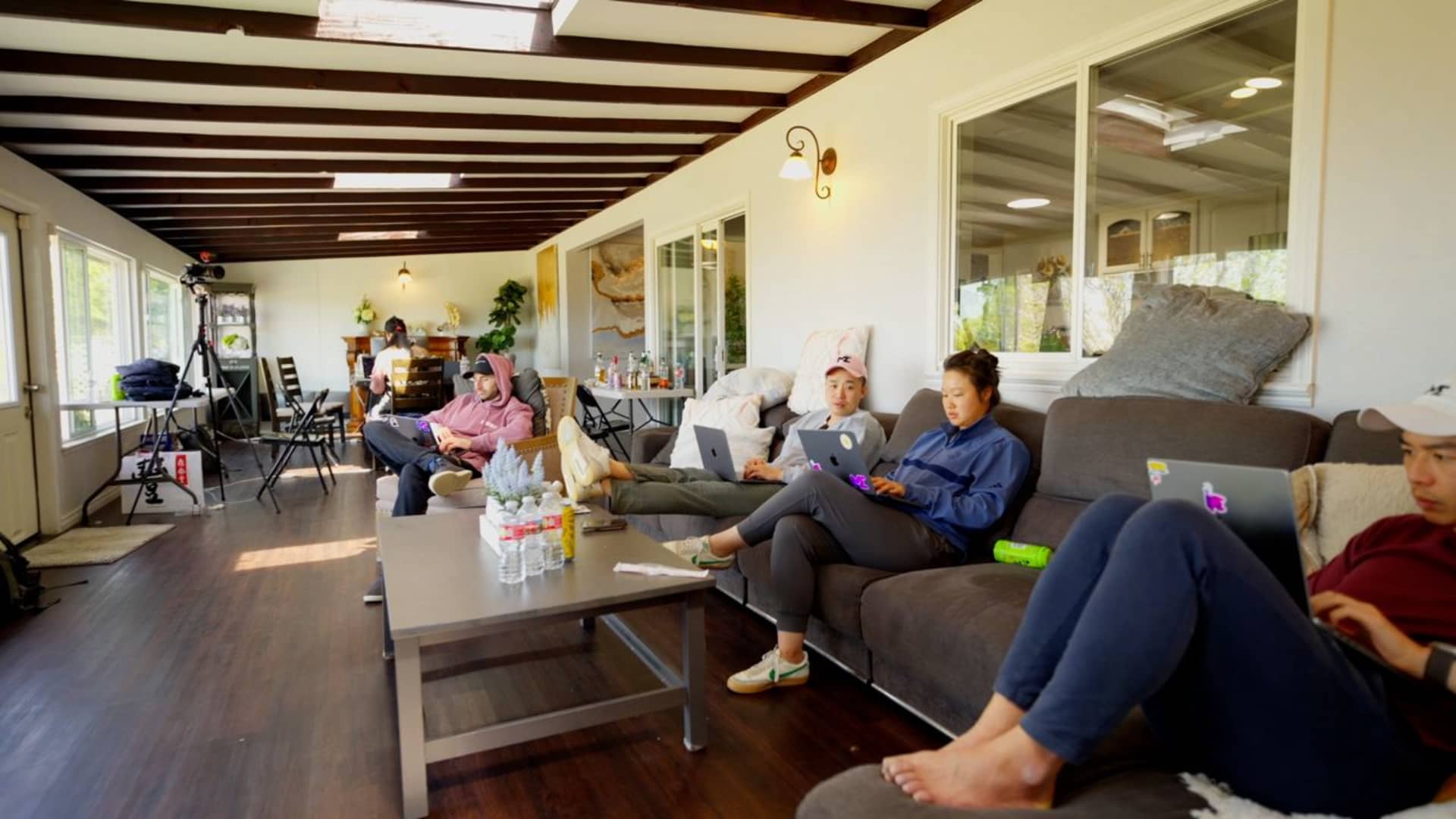

Magic Eden coders gathered in an Airbnb in San Jose, California, to hack in preparation for the so-called bitcoin halving.
Amil Husain
In the East Foothills of San Jose, California, 17 coders working for the popular ordinals marketplace maker, Magic Eden, piled into a 4-bedroom, 3,875 square-foot house rented on Airbnb. Their goal was to spend a week hacking to prepare for the so-called bitcoin halving — an event that is baked into the chain’s code and helps to stave off inflation through programmatic monetary policy.
A lot of the talk surrounding the halving, which happens roughly every four years, has been pegged to the fact that new issuance of the world’s largest virtual coin would be cut in half. But the block that locked in the halving also coincided with a couple other major launches on the blockchain, including cutting-edge programming innovations that are expected to draw both a lot more coders and a lot more venture capital dollars into the bitcoin ecosystem.
Also unlike past halving events, the world’s largest cryptocurrency touched a new all-time high above $73,000 in March as record flows entered the bitcoin ecosystem via the newly-launched spot bitcoin exchange-traded funds in the U.S.
“Bitcoin has never been healthier – what was missing previously was a vibrant developer ecosystem on top,” said Magic Eden’s co-founder and chief operating officer, Zedd Yin.
Some of Magic Eden’s coders took breaks from hacking to play arcade games.
Amil Husain
Arcade games and hard liquor
Magic Eden’s pop-up hacker house was modest but had a few bells and whistles that carried the skeleton crew through the week.
Those perks included Teenage Mutant Ninja Turtles and Street Fighter themed arcade-style machine games in the living room — plus a DIY open bar on a collapsible, plastic table in the dining room.
Engineers also went into the hackathon with the distinct advantage of knowing what they wanted to build. In the days leading up to the halving, Yin, 33, convened his team under the same roof in Northern California with one clear goal in mind: To code and launch the definitive marketplace for a new wave of digital products coming to bitcoin’s blockchain. On Monday morning, Magic Eden’s Runes Platform went live, helping to cement its place as the go-to forum to deal in these novel bitcoin offerings.
For years, rival chains like ethereum and solana have competed with bitcoin on functionality, because both have smart contracts — that is, programmable pieces of code — natively built into the base chain. That has been one of the chief reasons why developers around the world have flocked to these blockchains to build applications.
Magic Eden’s pop-up hacker house included arcade games and a ping pong table with a full bar.
Amil Husain
Enter Casey Rodarmor.
The popular bitcoin coder totally disrupted this dynamic last year when he introduced bitcoin’s version of non-fungible tokens known as ordinals, which developers ended up using as a base for bitcoin-issued coins called BRC-20 tokens. The launch was quiet, at first, but ultimately landed him tremendous acclaim.
Late Friday night, at the exact moment that the bitcoin halving initialized, Rodarmor unveiled his latest creation, runes, which is basically just a better and more efficient version of BRC-20 tokens.
“People really respect Casey and think that he sort of captured lightning in a bottle,” said Nic Carter of Castle Island Ventures. “And so there’s very high expectations for runes as well.”
Technically speaking, runes just enables asset issuance of fungible tokens on bitcoin’s base chain. That could be stablecoins, memecoins, or any variety of fungible token.
The reason this is significant to developers is because of its efficiency relative to existing BRC-20 tokens, bitcoin’s widely-used fungible token standard that has already received a ton of traction. Having a universally accepted token standard like this is seen as key to helping unlock scale of decentralized finance on bitcoin. Decentralized finance, or DeFi, is a parallel banking system that cuts out middlemen like lawyers and banks and relies upon code for enforcement.
“Fungible tokens are a significant part of every meaningful ecosystem like solana and ethereum, so runes is an important step in the evolution of bitcoin,” said Yin, who previously helped lead product for all institutional trading products at Coinbase.
Bill Barhydt, who runs Abra, a company that supports miners with a mix of services, including auto liquidations, and has access to macro data across the sector, said bitcoin simply cannot scale 100% on-chain via its own layer one. The problem has to do with the fact that bitcoin’s blockchain lacks the built-in smart contract capabilities necessary to reproduce the banking stack of a chain like ethereum or solana.
“BRC-20 tokens and ordinals, its successor runes, sidechains such as stacks, and DeFi on bitcoin are all showing strong promise in user adoption which stands to dramatically increase the demand for bitcoin block space and adoption, which I believe will create a positive feedback loop further driving bitcoin price gains in the coming years,” Barhydt said. “It’s truly remarkable the level of new development work happening around bitcoin,” he added.
Venture investors agree.
“I’ve never seen deal pacing move this aggressively in the bitcoin space in my entire career,” Carter tells CNBC.
For a week, the Magic Eden team gathered in an Airbnb in San Jose to work on the code for a new digital asset marketplace that would go live at the bitcoin halving block.
Amil Husain
Bitcoin ‘layer two’ interest spikes
Indeed, the VC appetite for these layer two bitcoin projects has been picking up in the last few months.
PitchBook says that the fourth quarter of 2023 was the first time in almost two years that deal value in the crypto sector had increased, reaching $1.9 billion — up 2.5% from the previous quarter. While still well off the 2021 high of $31 billion, funds are building back interest, and trust, in the space.
“There’s definitely been an awakening of capital interest in the bitcoin layer two space,” said Muneeb Ali, who co-founded Stacks — an open-source blockchain network that brings smart contracts to bitcoin.
Stacks is a separate chain to bitcoin but the two are able to work together. The project launched its own upgrade at the time of the halving block, as well, which reduced transaction time to five seconds, compared to the 10 to 30 minute block times tied to bitcoin’s base chain.
“Having so much VC interest just cements that the bitcoin ecosystem is primed to grow,” Ali said, who noted that the pace of projects launching on bitcoin has also picked up momentum in the last six months, from a half dozen projects going live to more than 50.
A new report released by Austin-based venture fund Trammell Venture Partners found that the bitcoin startup sector had a breakout year at the pre-seed stage, noting a 360% year-over-year increase in transaction count.
“Founders really want to be building on bitcoin specifically,” Christopher Calicott, the fund’s managing director and founding partner, said of the study’s findings.
The report also noted that early-stage, bitcoin-native startups raised just under $1 billion from 2021 through 2023.
Take Alpen Labs. The layer two project, which is bringing cutting-edge scaling technology known as zero-knowledge proofs to bitcoin, just emerged from stealth mode with Ribbit Capital leading a $10.6 million round. Another popular layer two solution dubbed “Build on Bitcoin,” or BOB, has raised $10 million in seed funding.
“Ordinals, BRC-20s and other innovations that came about in 2023 really helped build momentum ahead of the halving,” Ali said. “They made bitcoin fun again for developers and showed that users will favor NFTs, assets, and apps on bitcoin if given the opportunity.”
In the East Foothills of San Jose, California, 17 coders working for the popular Ordinals marketplace maker, Magic Eden, piled into a 4-bedroom, 3,875 square-foot house rented on Airbnb.
Amil Husain
DeFi on bitcoin rails
For years, developers have been trying to bake additional functionality into bitcoin’s base chain. Barhydt tells CNBC that demand for DeFi — specifically yield and lending — is a key driver of crypto adoption.
Sidechains like stacks, for example, have been working to bring the speed and competitive transaction costs of solana-type rails to the bitcoin ecosystem, in order to decongest the main chain and allow the overall bitcoin economy to scale.
With runes, these existing projects have a new tool they can use to grow, since it enables them to potentially plug into a native, lightweight token system on the main bitcoin chain rather than having to generate their own independent token environment.
“Runes presents an efficient system for creating and managing fungible tokens directly on bitcoin in a way that reduces blockchain bloat and improves scalability compared to other token standards,” said Hong Fang, president of crypto exchange OKX. “This has major implications for layer two solutions and sidechains that are working to scale bitcoin,” added Fang, who previously spent nearly a decade working at Goldman Sachs.
Stacks’s Ali has dubbed the post-halving environment “bitcoin season two.”
“Season two is all about the return of builders to bitcoin. Users are finally separating bitcoin the asset from Bitcoin, as the rails,” he said.
As for Yin and his team — one other big takeaway of the runes hackathon was the need for a bit more due diligence on Airbnb properties.
The team had an outdoor gas fireplace that wasn’t working so there was a constant smell of a gas leak the entire week, the rental’s WiFi was down for the entire first day — and a handful of folks got Covid.






